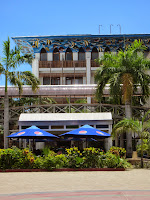It has been a while since we have written about what has been happening in the hangar. So here is an update from Mark ...
There has been lots happening and I have been learning so much. Our general work is performing inspections of our 2 Cessna caravans and 3 Cessna 206's, as well as our customers Caravans, 206's, 182 and 150. In just one month we performed regular inspections on three Cessna Caravans, and two Cessna 206's. All of this has helped me learn so much about so many different systems on the airframes.
Alongside these 'regular' inspections, we have been doing some more in-depth maintenance. One of our Caravans was due for an engine change. Therefore, we had to disconnect the engine from the airframe, remove the engine and then strip it down so that it could go into a container and get shipped to Covington, a PT6 engine overhaul shop in Oklahoma, USA. Then we built-up our new engine (a newly overhauled engine from MAF Uganda), and installed it back into the airframe. Unfortunately, we have had a few problems with this engine (some historical issues that did not get sorted out fully), so after a Covington engineer flew out here it investigate, the engine has flown back to Covington for them to fix what needs fixing (for those in the know ... the engine was suffering from compressor stall, but only when the Caravan's air plenum was in place).
This same aircraft is also undergoing a major avionics upgrade. We have removed all the navigation indicators and units and will be replacing them all with a Garmin G600 suite. I have been busy removing all the redundant circuit breakers and wires from the Power Distribution Panel and then installing all the new circuit breakers and wires that are needed for the new units. I will also be fabricating and installing new avionics shelves in the cockpit, under the floor and in the tail section. I will have more photos and will write about this again later (I promise!).
Another large task that I have been involved with a lot has been the complete inspection, strip and repaint of a Cessna 206 that belongs to Foxes Safari. This very intensive inspection is known as a 'Check 3' inspection and it pretty much means that every single part of the aircraft has to be stripped down and inspected. During doing all these inspections we have found quite a lot of corrosion. Corrosion is like aircraft cancer, and has to be removed wherever it is found or it could become deadly. You can see just a few of the corroded parts that we found. What is worrying, is the top right and bottom centre photos shows the rear wing attach bracket and carry thorough. If you understand aerodynamics, you will know that it is the wings that 'picks up' the rest of the fuselage when the aircraft takes off, and the whole fuselage hangs from these brackets. Not a good place to have corrosion.
Therefore, you can see that we have had to remove quite a bit of structure, chasing the corrsion through the structure to make sure we catch it all and either clean out the mild corrsion or replace those that are too badly damaged with new parts.
Life is never dull working as an aircraft engineer here for MAF. One highlight in recent months was being flown out to act as the 'breakdown mechanic' on a safari plane. Landing on a dirt runway next to a couple of giraffes, having flown over a herd of 11 elephants, I fixed the plane before heading home ... so it's not all about being stuck in a hangar!
































